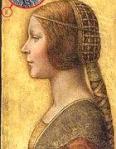Archive
Hidden Historic Treasures
Non-historians tend to think of history as a dead thing – dead people, dead civilizations, maybe some dead languages (and yes, with the passing of Mr. Garcia lo those many years ago, even Dead Heads seem a relic of the past). But some exciting discoveries in the past few weeks shows why history truly is a living entity, both because new facts are discovered and new theories develop, based on those facts or simply the ever-changing ideological winds.
A few months ago in England, a metal-detector-wielding amateur scooped pro archaeologists with his stunning find of 7th-century Anglo-Saxon gold and silver items, a discovery worthy of front-page play in the NYT. The cache included intricately worked items that adorned weapons and clothing, and experts think they were prizes ripped from defeated foes during or after battle. Under British law, the finder is due a sizable chunk for his share of the valuable find – somewhere around $1.5 million, by the latest estimate. Not bad for a middle-aged bloke who was on the dole while digging through the dirt. And the historians say the trove shows the level of craftsmanship at work during the time, an era often called “the Dark Ages.”
Some historians are increasingly claiming that the label is a misnomer. Sure, the Roman Empire was gone in the West, and the Renaissance (even the “mini-Renaissance” of the 12th century) was hundreds of years away. But Europe did not collectively crawl under a rock and wait to be revived by Abelard, Anselm, and Bacon; Chaucer, Petrarch, and Giotto (or even Tinkers, Evers, and Chance). The monks of the British Isles and elsewhere wrote and created art. Skilled artisans crafted the tidbits recently found . And beyond the borders of the old Western Roman Empire, Byzantium and the Arab empires kept classical thought alive and, particularly with the Arabs, expanded on it. Not so dreary after all, unless you were a feudal serf, who, one book says, lived lives of “unrelieved drudgery.”
Of course, once the Renaissance did hit, you saw some sparkling scientific and artistic achievement, and the appearance of perhaps the greatest “Renaissance Man.” Another recent discovery put good ol’ Leonardo da Vinci in the news. I’m glad I wasn’t the guy who had to relay the bad news to the previous owner of La Bella Principessa: “Yeah, that work you sold for $19k – well, it was actually done by da Vinci, and it’s probably worth, oh, 150. Million.” And what was the telltale sign that it was the master’s work? A fingerprint. Evidently Leonardo often got his hands all over his work, and some high-tech sleuthing revealed that a print on the principessa matched one on a known da Vinci work. OK, aside from thinking, “That guy who sold it was a moron,” you have to think that it’s cool to have another work from one of the greatest minds of all time. You have to, damnit.
(In the interest of fairness, let me say this story could take a twist; the Time article cited above points to a counterclaim – from an art dealer who once sold the painting – that it is not a Leonardo. We shall see.)
Our third find of historical import comes from Syria, card-carrying member – albeit second string – of the Axis of Evil. Gee, don’t you miss those heady days of early Bush II, with those pithy sayings and talks of crusades? Appropriately enough, the new discovery relates to the Crusades, the real ones, back when the monotheists unabashedly bashed it out in the Holy Land. Archaeologists working at an old crusader fortress, the al-Marqab Citadel, found murals depicting scenes of heaven and hell. The citadel started as an Arab fort in the 11th century, came under Greek control, then ended up with the Western Crusaders during the 13th century (my source for this is sketchy…).
The murals, about 8 feet by 11 feet, are on the walls of a chapel inside the fort and represent images of heaven and hell. A little more detail, courtesy of MSNBC: “The panel depicting hell shows people being tortured inside a wheel covered with knives and others being hanged and burnt, said Marwan Hassan, head of the Department of Antiquities in Tartous. The one portraying heaven includes saints surrounded by light colors.”
The experts say the artwork is rare, since the Crusaders moved around a lot and didn’t have time to do much painting (and there was all that fighting stuff too). The murals should give insight into the mindset of the Crusaders – or at least the ones stuck on this godforsaken slice of Syria, far from the hustle and bustle of Damascus and Jerusalem. It’s probably the equivalent of doing National Guard reserve duty in Yankton, South Dakota. (I’ve been to Yankton. I might prefer Syria – at least you can get decent hummus and falafel.)
For all three discoveries, the research goes on, new info will come out. The History Nerd gets excited about finds like these, as you can tell. Long-lost letters and documents are cool too. Even the diaries of common folk, hidden away in an attic, can reveal so much about an era. So, start hunting through Grandma’s old trunks, and if you see a guy with a gray beard walking around the Connecticut shore with a metal detector, it might be me.





Recent Comments